-

人教版新目标初中英语九年级下册Could you please tell me where the restrooms are教案
Step Ⅰ RevisionCheck homework. Ask a few students to read the article in 3a.Then ask a few students to read their guides.Step Ⅱ Part 1Look at the words in the box. Ask a student to read them. Make sure the students understand the meaning of the words. You are to fill in the blanks with the words. In some cases, students may need to use another form of the word, for example adjusting for tense or subject/ verb agreement.Ask students to fill in the blanks on their own.Check the answers. Step ⅢPart 2Go through the instructions with the class.Look at the example with the students.Ask students what the answer would be.Ask a student to read the question and answer it.Excuse me, could you tell me where the bank is, please?The bank is across the street from the shopping malt.Get students to complete the work in pairs.Check the answers. Ask a few students to read their questions.Step Ⅳ Just for Fun!Ask all the students to read the conversation. Ask: What is funny about this cartoon? Help students to explain. A Martian is a person from the planet Mars.There is no such thing as Martian food on Earth, and the clerk looks silly because he is trying to think of where there is a Martian restaurant.Invite some pairs of students to present this conversation to the rest of the class.Step Ⅴ Summary and HomeworkIn this class, we’ve done much writing practice using the key vocabulary words and the target language presented in this unit. After class, please finish the questions in 2 in your exercise books. Then finish the exercises on pages 47~48 of the workbook as well.The Seventh Period Ⅰ Teaching Aims and Demands1. Knowledge Objects(1) Key Vocabularyimage, adventure, jealousy, hero, crime, journey, brave, no longer, show interest in, take it easy, become interested in, plain looks(2)Text:Grown-ups like cartoons, too.2. Ability Objects(1) Fast-reading to get a general idea of the text.(2) Careful-reading to get the detailed information in the text.

人教版新目标初中英语九年级下册We’re trying to save the manatees教案2篇
本单元主要围绕着有关濒临灭绝的动物这一话题,学习了应该怎样保护我们的环境,以及就某一问题展开辩论。目标提示语言目标能够运用所学知识,就某一问题展开辩论。认知目标1、复习一些语法:现在进行时、一般现在时、用used to 表示一般过去时、现在完成时、一般过去时的被动语态。2、学会表达同意和不同意。3、学会以下基本句型:We’re trying to save the manatees.Manatees eat about 100 pounds of food a day.There used to be a lot of manatees.In 1972,it was discovered that they were endangered.Some of the swamps have become polluted.情感目标了解一些濒临灭绝的动物的生活习性和濒临灭绝的原因,教育学生应该如何保护环境。教学提示充分利用多媒体等教学设备,创设与本课话题相关的情境,如各种不同种类的动物、动物园以及有关环境的画画等等。围绕着本单元的教学目标,设计一些贴近学生实际的教学任务,如让学生谈论自己最喜欢的动物,如何拯救濒危动物,如何保护环境等等。让学生根据所学知识,就动物园是否对动物有利以及其他的话题进行辩论。

人教版新目标初中英语七年级下册What does he look like教案3篇
所需要用到的句子:Who is that?That is Jack. I like him.Why do you like him?I like him because he is interesting.Task 4: 设计理想中的人类Step one: 设计理想中的人类的外貌。把全班同学分成若干小组,学生可以边说边在纸上画出他们的模样。Step two: 设计理想中人类的性格。学生们可以把那些能描述性格的单词写在图画的旁边。Step three: 每组选出一名同学,其他同组同学提问,他作简单回答,并说明原因。所需用到的句子:What does he or she look like?He or she ...What is he or she like?He or she is ...Why?Because ...Task 5: 挑战性活动调查性格是天生的还是后天形成的,让每个同学回家去调查一下自己成长过程中性格是否有变化,具体是怎样的,为什么会这样? Teaching Aims:1. Enable students to have a general understanding of how to talk about people's physical appearance.2. Enable students to tackle some essential vocabularies and patterns about describing people. Provide them with necessary skills and methods.3. Create various chances for students to describe the persons they're familiar with, such as classmates, family members, teachers, idols, etc.

人教版新目标初中英语七年级下册Don’t eat in class教案2篇
Don’t fight. =You can’t fight. (板书,教读)教师把这些句子板书在黑板上,并请学生大声整齐地读祈使句和“can’t”句型,并让学生注意两种句型表达形式的不同和转换,“Don’t …=You can’t…”;并对学生说:These are our school rules. (板书,教读) You can’t break the school rules. Don’t break the school rules.(板书,教读)步骤3 :Practicea. T: Now, each of the students is breaking one of these rules.Please finish 1a.学生看图,完成1a的内容,检查答案并大声朗读校规。b. 听录音,完成1b,选出四位学生都违反了哪条校规;听之前,学生要读会英文名。c. 请两位学生朗读1c部分的句型;要求学生两人一组对话表演,SA扮演外校转来新生,SB告知本校校规。(学生可经过讨论,多说出他们想到的校规,不必只限于书上;教师应给予帮助)2) 第二课时(2a~4)步骤1 :warming up of revisionT: What are the rules at your school?学生使用“can”或祈使句表达各条校规;其中老师可引出“eat in the cafeteria outside”的表达。步骤2 :Practicea.T: Christina is an exchange student. She doesn’t know the rules. Let’s listen, what activities they’re talking about?学生听第一遍时,完成2a;第二遍时,完成2b;b. 请学生领读2c部分,看着2a完成的表格,理解2c活动的要求;分成小组针对2a进行问答;

人教版新目标初中英语七年级下册I ’d like some noodles教案
教学过程Step 1: warming-up Sing a song---------“food and drink” Step 2: Revision1 Dictation2 Revise: What kind of noodles would you like?I’d like …What size bowl of noodles would you like?I’d like…Step 3: Presentation1 show pictures of food, ask students say the words.2 Students read the newspaper ad in 3a. Fill in blanks with words in the box. Then read the ad together, the teacher explains some difficult language points.3 Check the answers Step 4 PracticeAsk students to finish 3b in the same way according to 3a. Students read the short passage and fill in the blanks .At last, check the answers.Step 5 productionAsk students to write their own ad for dumplings, noodles, drinks, and other foods they know. Then ask students to read their partner’s ad. Then order food and drink from their partner.Step 6 Home workGroup work – make an ad about “food and drink”

人教版新目标初中英语七年级下册I want to be an actor教案2篇
三、教学建议第一课时:1. Lead in (Vocabulary)A) Before class, teacher should collect some pictures of working places. For example: Bank, TV Station, Restaurant, Police Station, Hospital ...B) In class, show students the pictures (PowerPoint, OHP). Ask students to tell the name of the working places and the name of the jobs.Shop assistant, doctor, actor, reporter, police office, waiter, bank clerk, studentC) Do exercise 1a and 3a.2. Bingo GameAsk groups of students to make up pairs of cards with a job on one and the related workplace on the other. For example, waiter / restaurant, teacher / school, doctor / hospital. Encourage students to use both the job / workplace combinations in the book and the ones that students came up during class discussions. Be sure they have twice as many sets of cards as there are students in the group. They can make two sets of cards for a single job / workplace, if necessary. Then have each group mix up its set of cards and hand their cards out in random order. Each time a student gets a pair of cards that match, he or she can lay these cards down. The goal is to have no cards in your hand at the end.3. Task OneA) Ask students to work in pairs and ask the partner what does he / she want to be in the future.e. g. :What do you / does he / does she want to be?I want to be a.Why?Because it's (adj).B) Vocabulary: Section B, 1a4. Homework 1.2.

人教版新目标初中英语七年级下册Why do you like koalas教案2篇
单元整体说明(一)单元教材分析本单元的核心话题是描述动物和表达个人喜好,以及句式why do you like…? Because…。这也是本单元的教学重点。通过本单元的学习,学生应能较流利地运用所学词汇和句型描述动物,表达个人喜好。(二)单元知识结构1.词汇动物名称 tiger, elephant, koala, dolphin, etc.词汇描述性形容词: smart, cute, ugly, clever, shy, etc.国家名: Australia, South Africa2.句型Why do you like koala hears? Because they are cute.Where are pandas from? They're from China.What animals do you like? I like dolphins.(三)单元整体目标1.Master the vocabulary2.Master and use: Why do you like koalas? Because they am cute.Where are pandas from? They're from China.What animals do you like? I like dolphins.(四)单元教学重难点一览(五)单元学情分析学生此前已经学过由why, where, what 引导的特殊疑问句句型,具有了学习本单元知识的认知前提。形形色色的动物能激发学生的好奇心,产生了解它们的欲望,这有利于本单元知识的教学和学生学习兴趣的培养。

人教版新目标初中英语八年级下册How long have you been collecting shells教案2篇
Step Ⅱ Show the new words on the screen and teach the new words. Read the new words to students and ask them to repeat.Step Ⅲ 3aThis activity introduces new vocabulary and provides reading practice using the target language.In this activity first look at the four pictures.T: What can you see in the pictures?Ss: Four snow globes.T: Right. There are four snow globes in the pictures. And what are they?Ss: They are a monster, two polar bears, two penguins and a birthday cake.Write these words on the blackboard: snow globe; monster; polar bear; penguin and birthday cake. Read them to the class and ask students to repeat each one. Make sure students understand each word.Use a computer to show the E-mail message on the screen and read the message to students.Get students to read the e-mail on their own, and then draw lines connecting each snow globe and its description.Correct the answers.AnswersA line should connect each snow globe picture with the words that describe it in the letter.Step Ⅳ 3bThis activity provides writing practice using the target language.First review Activity 2a on Page 47.Then ask students to complete the message according to Activity 2a.Some partial sentences are given to students. Write about one person's collection.When students work, walk around the room checking the progress and offering help as needed.When they finish, ask some students to read their messages to the class.

人教版新目标初中英语八年级下册Would you mind turning down the music教案
Step 4. Group work (4)1. Ask a pair of students to read the dialogue. Say, This activity provides speaking, listening and writing practice using the target language.2. Ask students to complete the work in groups.3. Check the answers with the whole class. 4. Explain some of the language points. Step 5. Word review (Self check 1)1. Ask students to read the words and the phrases given. 2. Fill in the blanks with proper forms of these words to complete the sentences. 3. Check the answers with the whole class. Homework:Do activity 2 on page 57 after class. Period 6Teaching aims: 1. Teach vocabulary words and the useful expressions. 2. Enable the students to learn etiquette in different culture. 3. Help the students learn how to behave politely in public places and in daily life. Teaching procedures:Step 1. RevisionHelp students to review the function of making requests through a free talk. Then lead them to the topic of etiquette. Explain the meaning of etiquette. Or, ask students to look it up in the dictionary. Step 2. Pre-reading (Section 1)1. Ask students to read the picture and make a list with their partner about how many rules of etiquette can be seen being broken.

人教版新目标初中英语九年级下册I’ll help clean up the city parks教案
Talk about offering help (P60)I’ll help clean up the city parks.A: I’d like to work ...B: You could help ...Talk about ways to tell people about the Clean-Up Day (P61)We need to ...We can’t ...I’ll ...Talk about the work the volunteers do (P62)These three students all volunteer their time to help other people.Somebody loves to ... / helps ... / plans to ... / wants to ...A: What do you like doing?B: I like ... A: What kind of volunteer work do you think I could do?B: You could ...1. 重点词汇advertisement, fix, repair, pleasure, blind, deaf, shut, carry, specially, fetch2. 认读词汇hunger, homeless, cheer, clean-up, sign, establish, major, commitment, elementary, veterinarian, coach, similar, call-in, strategy, disabled, organization, unable, support, appreciate, donation, part of speech, pronoun, adverb, preposition, conjunction, donate, Jimmy, Sally3. 词组clean up, cheer up, give out, put off, set up, think up, take after, fix up, give away, put up, hand out, work out, at once

人教版新目标初中英语九年级下册You’re supposed to shake hands教案
教学目标:1. 掌握本单元一些重点词汇的写法和用法。2. 学会自如谈论餐桌礼仪。Step 1 RevisionAsk some students to retell the customs at the table in France in the passage in 3a.Step 2 Self checkPart 1. Fill in each bland with the correct word given. Students do the exercises by themselves at first. Then check the answers. Ask the students to comprehend the sentences and help them point out uses of some words, like “arrive (at / in) sw., spend time / money on sth , spend time / money (in) doing sth.”Part 2. Read about Fan Ling’s experience in a western restaurant. Understand the passage. Point out some key points in the passage.1. be / get used to doing sth. 习惯做某事2. begin with = start with 以….开头3. crowd v. 挤满,塞满 the crowd 人群 crowded adj. 拥挤的Then students discuss about how she would solve her problem. Ask some to share their stories with others.Part 3. Complete the crossword by looking at the sentences on the left. Then check the answers.
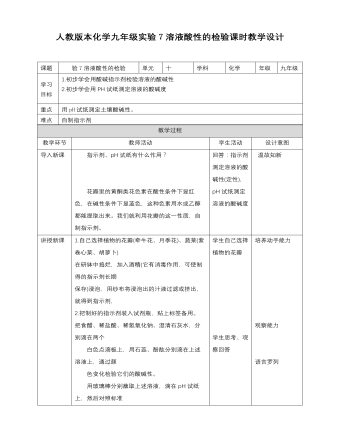
初中化学人教版九年级下册《实验活动7溶液酸碱性的检验》教案
1.自己选择植物的花瓣(牵牛花、月季花)、蔬菜(紫卷心菜、胡萝卜) 在研钵中捣烂,加入酒精(它有消毒作用,可使制得的指示剂长期 保存)浸泡,用纱布将浸泡出的汁液过滤或挤出,就得到指示剂, 2.把制好的指示剂装入试剂瓶,贴上标签备用。 把食醋、稀盐酸、稀氢氧化钠、澄清石灰水,分别滴在两个 白色点滴板上,用石蕊、酚酞分别滴在上述溶液上,通过颜 色变化检验它们的酸碱性。 用玻璃棒分别蘸取上述溶液,滴在pH试纸上,然后对照标准 比色卡比较,得出pH值,也就是酸碱度。 把上述溶液滴在白色点滴板上,用滴管吸一下你自制的指示剂,滴在滴板的溶液里,观察颜色变化,每用一种指示剂,换一下滴板的溶液。 把所得到颜色变色变化的信息和pH值数据填入教材第70页的表中。 3.取少量土壤样品,将土壤样品与蒸馏水按1∶5的质量比在烧杯中混合, 充分搅拌后静置,用玻璃棒蘸澄清的液体,滴在pH试纸上,然后对照 标准比色卡记录读数。
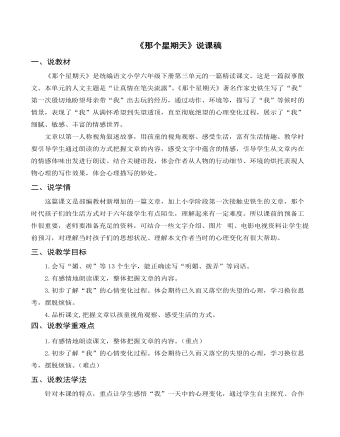
部编人教版六年级下册《那个星期天》说课稿
一、说教材《那个星期天》是统编语文小学六年级下册第三单元的一篇精读课文。这是一篇叙事散文。本单元的人文主题是“让真情在笔尖流露”。《那个星期天》著名作家史铁生写了“我”第一次殷切地盼望母亲带“我”出去玩的经历,通过动作、环境等,描写了“我”等候时的情景,表现了“我”从满怀希望到失望透顶,直至彻底绝望的心理变化过程,展示了“我”细腻、敏感、丰富的情感世界。 文章以第一人称视角叙述故事,用孩童的视角观察、感受生活,富有生活情趣。教学时要引导学生通过朗读的方式把握文章的内容,感受文字中蕴含的情感,引导学生从文章内在的情感体味出发进行朗读。结合关键语段,体会作者从人物的行动细节、环境的烘托表现人物心理的写作效果,体会心理描写的妙处。

部编人教版四年级下册《乡下人家》说课稿(二)
(一)音画同步,创设情境感知文章结构,明确学习任务上课伊始,教师先出示乡下风光的多媒体课件,配乐旁白:这是顺着棚架爬上屋檐的碧绿藤蔓;这是依着时令次第开放的鲜花;这是茂密竹林中破土而出的春笋;这是觅食的鸡群戏水的小鸭。这里就是充满诗情画意的乡下人家。在作者的眼里乡下人家的画面是怎样的?学生借助第一课时感知的框架,加上画面的重现,在文字的引领下,下乡来了解这是什么样的“家”,是怎样的“人”。学生能在最短的时间内引发阅读期待,走进乡下人家。为深入感知理解课文内容,体会作者描写上独特的表达方式奠定了基础。(二)整合内容,教师导学细化理解方法,夯实学习实效教师引导学生整体感知后直奔中心:“独特、迷人”来统领全文教学,抓住文章第一自然段明确用“抓重点句、关键词”的方法品味风景“独特”在哪里,“迷人”在何处?这样激起了学生探究作者是怎样用文字生动形象地描述一幅幅画面的欲望。联系生活实际理解对比的描写方法并不难,抓住动词体会也很容易,但是透过文字提取情感,再联系落实到朗读感受就是需要教师具体操作,学生体验实践的最具实效的学习历程。

部编人教版四年级下册《 千年梦圆在今朝》说课稿
【说目标】教学目标1.正确读记“尝试、火焰、捆绑、身躯、探索、惨重、穿越、振奋、规模、协作、嫦娥奔月、炎黄子孙”等词语。2.默读课文,抓住课文的主要内容,了解中国航天事业的发展历程和千年梦圆的经过,激发民族自豪感。3.学习在具体的事实描述中说明道理的写法,体会中国航天人团结合作、默默奉献、勇于探索、锲而不舍的科学精神。教学重难点1.了解中国航天事业最终实现梦想的原因,从中体会中国航天人所体现的团结合作、 默默奉献、 勇于探索、锲而不舍的科学精神, 激发学生的民族自豪感。2.学习在事实的描述中说明道理的写法。这篇课文激情澎湃,字里行间充满了中国人民实现飞天梦想的自豪与骄傲。教学这一课,我注重引导学生用朗读从字里行间品味自豪和骄傲的感情。
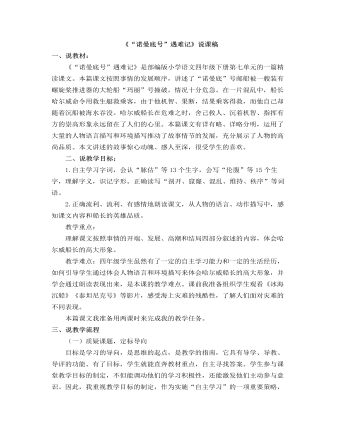
部编人教版四年级下册《 “诺曼底号”遇难记》说课稿
教学难点:四年级学生虽然有了一定的自主学习能力和一定的生活经历,如何引导学生通过体会人物语言和环境描写来体会哈尔威船长的高大形象,并学会通过朗读表现出来,是本课的教学难点。课前我准备组织学生观看《冰海沉船》《泰坦尼克号》等影片,感受海上灾难的残酷性,了解人们面对灾难的不同表现。本篇课文我准备用两课时来完成我的教学任务。三、说教学流程(一)质疑课题,定标导向目标是学习的导向,是思维的起点,是教学的指南,它具有导学、导教、导评的功能。有了目标,学生就能直奔教材重点,自主寻找答案。学生参与课堂教学目标的制定,不但能调动他们的学习积极性,还能激发他们主动参与意识。因此,我重视教学目标的制定,作为实施“自主学习”的一项重要策略,把它作为课堂教学的首要环节。上课开始,我是这样安排的:
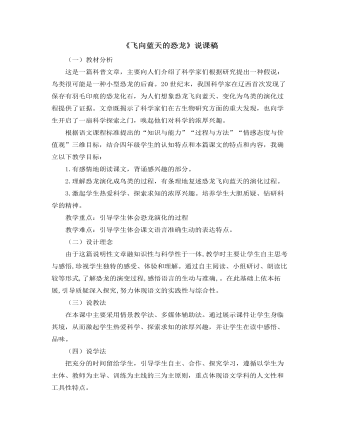
部编人教版四年级下册《 飞向蓝天的恐龙》说课稿
二、精读重点段,理解演化过程接下来我直奔重点-——课文的第3、4自然段。我以“让我们穿越时空隧道,一起去中生代的地球,看看恐龙的演化过程”这一陈述,十分自然地引出后面的学习。在学习中,我紧紧围绕“恐龙是如何飞向蓝天的”这一问题,设计了合作学习表格,教给学生抓关键词来填表格的方法,引导学生边读边思考,学会学习,学生在完成表格的过程中,不仅理清了课文的叙述顺序,也清楚地知道了恐龙飞向蓝天的过程。有了表格的提示,学生们把课文梳理得更清楚简洁。我又通过填空,图片解说,以及不同形式的朗读进一步加深印象。学生通过自主的,入情入境的朗读,读懂了课文。读的要求明确,读的时间充足,读的层次清楚,使学生亲历阅读过程,走进文本。

部编人教版四年级下册《记金华的双龙洞》说课稿(二)
二、说教学目标根据学生实际以及对教材的分析理解,我从知识和能力,过程和方法,情情感态度价值观三个维度确定我的教学目标共有3个。1.认识“浙簇”7个生字,会写“浙罗”15个生字。正确读写“一簇杜鹃突兀森郁臀部漆黑蜿蜒”等词语。2.有感情地朗读课文,能复述“双龙洞”的景象,感受大自然的壮观。3.理解课文记叙的游览顺序,学习有条理叙述的表达方式;体会作者用词造句的准确和朴实。4.感受金华双龙洞自然景观的美,激发学生热爱大自然的情趣。教学重点:深入理解课文内容,理解课文记叙的游览顺序,学习有条理叙述的表达方式;体会作者用词造句的准确和朴实。教学难点:能够根据作者的叙述,画一幅金华双龙洞的景点游览图并能够介绍一处印象最深的景点。教学准备:多媒体课件
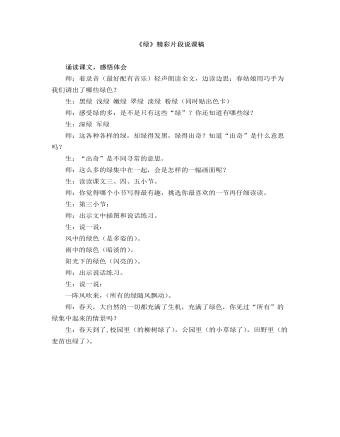
部编人教版四年级下册《绿》精彩片段说课稿
诵读课文,感悟体会师:着录音(最好配有音乐)轻声朗读全文,边读边思:春姑娘用巧手为我们调出了哪些绿色?生:黑绿 浅绿 嫩绿 翠绿 淡绿 粉绿(同时贴出色卡)师:感受绿的多:是不是只有这些“绿”?你还知道有哪些绿? 生:深绿 军绿 师:这各种各样的绿,却绿得发黑,绿得出奇?知道“出奇”是什么意思吗?生:“出奇”是不同寻常的意思。师:这么多的绿集中在一起,会是怎样的一幅画面呢?生:读读课文三、四、五小节。
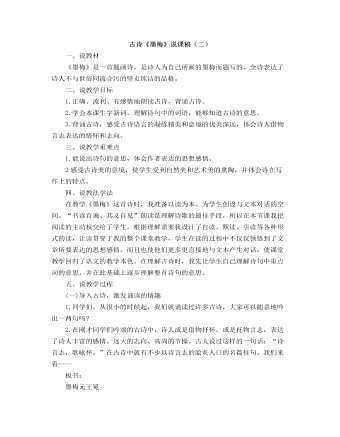
部编人教版四年级下册古诗词三首《墨梅》说课稿(二)
一、说教材《墨梅》是一首题画诗,是诗人为自己所画的墨梅而题写的。全诗表达了诗人不与世俗同流合污的坚贞纯洁的品格。二、说教学目标1.正确、流利、有感情地朗读古诗,背诵古诗。2.学会本课生字新词。理解诗句中的词语,能够知道古诗的意思。3.背诵古诗,感受古诗语言的凝练精美和意境的优美深远,体会诗人借物言志表达的情怀和志向。三、说教学重难点1.能说出诗句的意思,体会作者表达的思想感情。2感受古诗美的意境,使学生受到自然美和艺术美的熏陶,并体会诗在写作上的特点。

